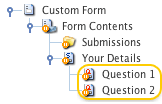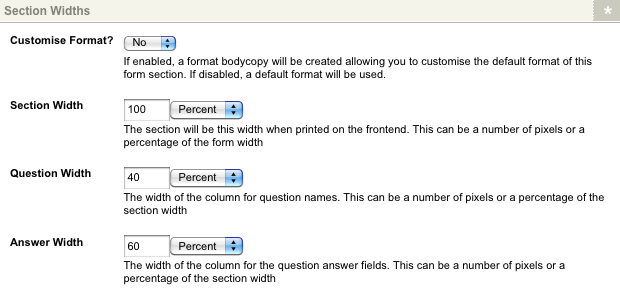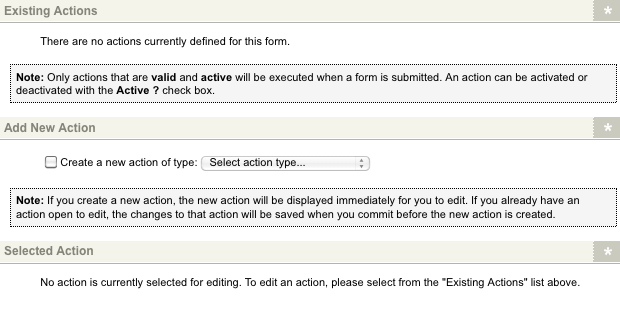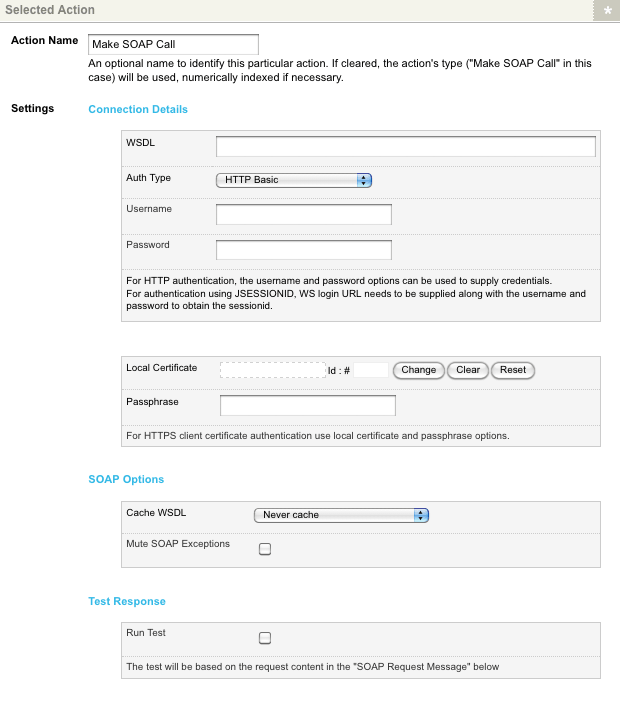Custom form sections
Form sections allow you to group similar form fields for a custom form. For example, if you have a group of form fields for the users' contact details, you can group them under a section called Contact details.
One significant advantage of using sections is that you can clone or link a section in the asset tree to another custom form. This feature allows you to reuse form fields within your system. You cannot clone or link a question created outside a section.
Adding a section
To add a section to the custom form:
-
Right-click on the Form contents asset in the asset tree.
-
Select Form contents.
-
In the Sections part of the screen, enter the section’s name in the Add sections field.
-
Click Save.
The section displays in the current section list:

A section asset will also appear in the asset tree, as shown in the figure. You can add as many sections as you want to the form.

Each added section displays in the Current sections area. Click the section name to load the Details screen and add form fields to that section. For more information about the Details screen, refer to the Editing a section part of this chapter.
Once you have added a section to the custom form, you can configure its settings on its associated asset screens.
Details screen
The Details screen allows you to add form fields and sections to the section and customize the form fields' widths in the section. Read the Asset details screen documentation for more information about the Status, Future status, and Thumbnail sections.
Details
By default, the name entered when you created the section displays in this section. The details section of the Details screen:

You can change the section’s name by clicking into the name field and entering the section’s new name.
Form fields
This section allows you to add form fields to a section. The form fields section of the Details screen is shown:

To add a form field:
-
Select the question type in the Add form fields field.
-
Nominate how many fields to add of this type (for example, if you want to add two text type fields, select
2). -
Click Save.
The form fields will be listed in the current form fields section, as shown:


A form field asset also appears in the asset tree under the section asset for each question added.
Each form field displays the following information:
- Question
-
This shows the name of the question. When you click on the question name, the Details screen will be displayed to modify that question’s settings. The content of the Details screen will depend on the type of question you have selected. For more information about each question type’s Details screen, refer to the form field type chapters in this manual.
- Type
-
This shows the question type added.
- Delete
-
This field allows you to delete a question from the form.
To do this:
-
Click on the Delete box.
-
Click Save.
Alternatively, to delete all form fields on the form:
-
Click the box at the top of the column.
-
Click Save.
-
- Move
-
This field allows you to re-order the form fields for the form.
To re-order the fields:
-
Click on either the Up arrow icon up or Down arrow icon down arrow to move the field.
-
Click Save when you have finished ordering the fields as required.
-
You can add additional form fields to the form by using the Add form fields field.
Nested sections
This section lists the sections added to the current section and allows you to add new sections.
The nested sections section of the Details screen is shown in the figure:


To add a section:
-
Enter the section’s name in the Add sections section.
-
Click Save to display the section in the current section list.
A section asset will also appear in the asset tree. You can add as many sections as needed to the form.
Each added section displays in the Current sections area. Click the section name to load the Details screen and add form fields to that section.
Section widths
This section allows you to customize the widths for the form fields added to this section. The section widths section of the Details screen:

- Customize format
-
If enabled, a new custom format bodycopy asset will be created in the asset tree, allowing you to customize the format and layout of this form section.

When you disable this option, the system deletes the customized bodycopy and substitutes it with a default format.
- Section width
-
Enter the width for the section when displayed on the custom form. Select Pixels from the list provided to specify an absolute value for the width. Select Percent to specify the width as a percentage of the window’s width.
- Question width
-
Enter the width of the column used for the title of the form fields. Select Pixels from the list provided to specify an absolute value for the width. Select Percent to specify the width as a percentage of the window.
- Answer width
-
Enter the column’s width used for the answer fields. Select Pixels from the list provided to specify an absolute value for the width. Select Percent to specify the width as a percentage of the window.
Step actions screen
The step actions screen allows you to create custom actions run on a step or page (that is, section) of a multi-page custom form. These actions include sending a message to a remote SOAP server on completion of a form step. The Existing actions, Add new action and Select action sections are available as described below:

Adding a Make SOAP call action
To add a new step action to send a message to a remote SOAP server:
-
Check the Create a new action of type option in the Add new action section.
-
Select the Make SOAP call.
-
Click Save.
| The Make SOAP call action supports both SOAP 1.1 and SOAP 1.2 standards. This step action does not currently support WS-Security features and MIME multi-part attachments. |
The action will be added to the existing actions section, as shown:

Additional fields will also appear in the selected action section, as shown:

The Make SOAP call step action works similarly to the custom form’s Make SOAP call submission action. Read the Custom form contents documentation for more information on how to configure these settings.